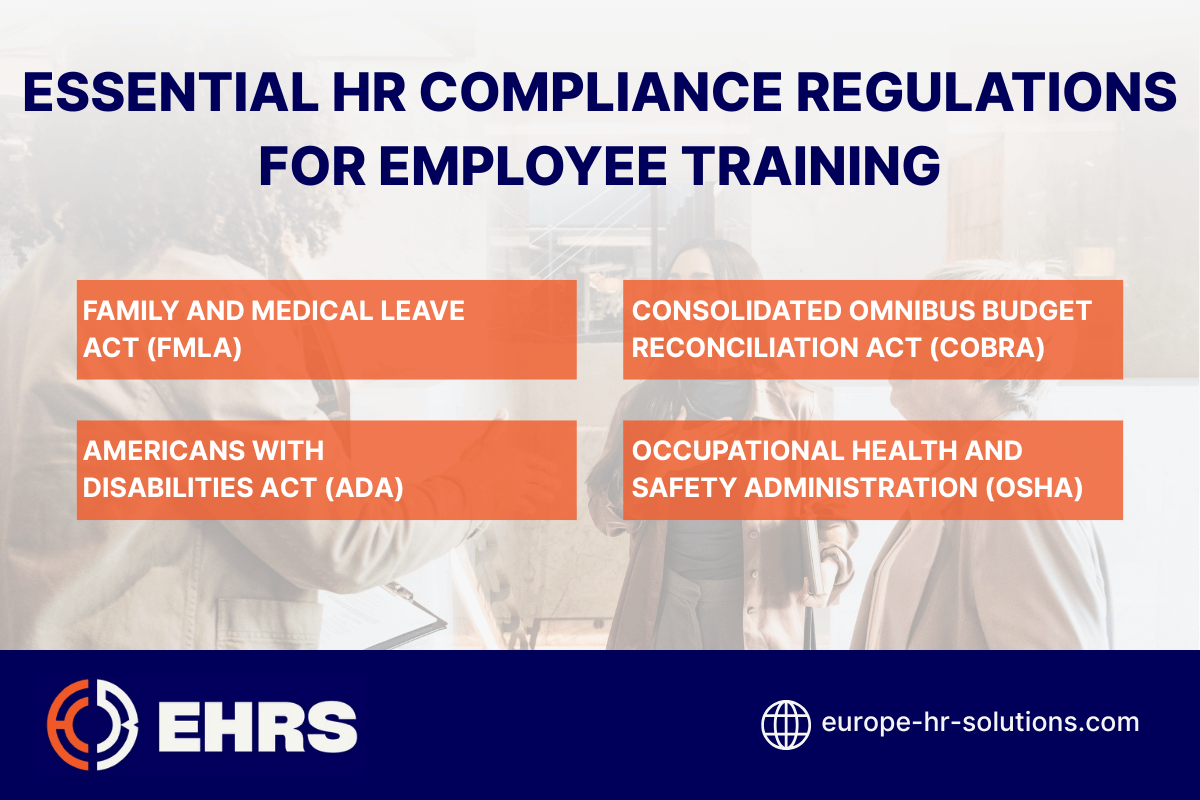This comprehensive guide explores important regulations like FMLA, ADA, and COBRA, offering actionable insights into employee compliance training programs and courses designed to help HR professionals implement a structured approach.
Discover how prioritizing these requirements can mitigate risks, ensure workplace safety, and foster a culture of legal adherence and inclusivity.
Essential HR Compliance Regulations for Employee Training
HR compliance training for employees educates organizations on legal obligations regarding non-discrimination, workplace safety, and labor laws. It covers regulations like FMLA, ADA, COBRA, and OSHA, ensuring companies meet federal and state requirements. This training helps employers avoid penalties while fostering ethical practices and employee accountability.
HR departments face challenges adapting to evolving laws, such as salary transparency mandates in New York and cybersecurity risks. Nearly half of U.S. adults have experienced data breaches, emphasizing the urgency of compliance. Legal requirements include anti-discrimination protections (ADA, ADEA), wage standards (FLSA), and health benefit accessibility (ACA, COBRA), which demand constant regulatory vigilance.
| Regulation | Scope | Key Requirements |
| FMLA | Eligible employees’ unpaid leave for family/medical reasons | Maintain health coverage, restore employment status post-leave |
| ADA | Accessibility for employees with disabilities | Provide reasonable accommodations, ensure inclusive communication |
| COBRA | Health coverage continuation post-employment changes | Notify qualifying events, offer 18-36 months of coverage |
| OSHA | Workplace safety standards | Implement hazard assessments, provide safety training |

Non-compliance risks cost businesses an average of $14.82 million annually. For example, a company paid $460,000 after an age discrimination case. Cybersecurity violations alone averaged $4.88 million per incident in 2024, underscoring the financial stakes of inadequate training.
Structured compliance training reduces legal liabilities and reputational damage. Companies with proactive programs report 73% better stakeholder trust. By aligning practices with regulations like FMLA and ADA, businesses create safer work environments and avoid costly litigation.
FMLA Training: Managing Family and Medical Leave Requirements
The Family and Medical Leave Act (FMLA) allows eligible employees to take 12 weeks of unpaid, job-protected leave for qualifying medical or family reasons. Employers with 50+ employees must comply, ensuring health coverage continuity and proper documentation. Training helps avoid legal issues tied to eligibility misinterpretation or coverage lapses.
Employers must maintain group health insurance for FMLA-eligible employees under the same terms as active employment. Workers must continue premium payments during leave. Failure to pay premiums may result in coverage termination, though employers must provide 15-day written notice before cancellation.
Employees trigger COBRA eligibility for continued coverage. Employers must notify plan administrators within 30 days of the qualifying event. Spouses and dependents have 60 days to elect COBRA coverage, maintaining benefits at active employee rates.
Managers need clear guidance on FMLA recognition, eligibility criteria, and documentation protocols. Training should address intermittent leave management and anti-retaliation policies. In 2018, 53% of 1,011 FMLA complaints resulted in violations, costing employers $1.76 million in back wages.
1. ADA Compliance: Reasonable Accommodations and Workplace Accessibility
The Americans with Disabilities Act (ADA) prohibits employment discrimination against qualified individuals with disabilities. Employers with 15+ employees must provide reasonable accommodations, ensuring equal access to job opportunities. This federal law reshapes workplace policies by mandating accessibility standards and anti-discrimination measures across hiring, promotions, and workplace practices.
Employers must provide accommodations enabling employees with disabilities to perform necessary job functions. These include modified workstations, flexible schedules, and assistive technologies. Accommodations aren’t required if they cause undue hardship. The Equal Employment Opportunity Commission (EEOC) enforces these requirements, which apply to 29% of working-age Americans with disabilities.
- Legal Framework and ADA Awareness: Cover the ADA’s purpose, historical context, and legal obligations regarding non-discrimination and accessibility standards.
- Disability Recognition and Practical Application: Train on identifying visible and invisible disabilities through real-world scenarios and role-playing for accommodation requests.
- Inclusive Communication: Emphasize disability etiquette, respectful interactions, and communication practices to foster an inclusive workplace culture.
- Leadership Engagement and Interactive Training: Ensure management leads by example while incorporating interactive elements like Q&A sessions and expert-led modules.
Health benefits during ADA-related unpaid leave follow existing company policies. If extended beyond Family and Medical Leave Act (FMLA) protections, continuation depends on standard eligibility criteria. Employers must apply coverage rules consistently, avoiding differential treatment of employees on disability-related leaves compared to other unpaid leaves.
Part-time reclassification triggering COBRA occurs when reduced hours remove group health plan eligibility. Employers must offer continuation coverage under the same terms as other qualifying events. This applies to 18-36 months of potential coverage continuation for affected employees and dependents.
Effective ADA training requires multi-tiered approaches. Organizations should utilize ADA National Network resources, including webcasts and in-person sessions. The 17-year-old National ADA Symposium provides updated implementation strategies. Consistent policy enforcement and accessibility audits ensure compliance across all operational levels while maintaining legal defensibility.
2. COBRA Requirements: Continuation of Health Coverage Training
COBRA (Consolidated Omnibus Budget Reconciliation Act) enables employees to retain health coverage after qualifying events. Employers with 20+ employees must comply. HR compliance training for employees ensures adherence to laws governing coverage continuation, preventing legal risks. This regulation requires clear communication and precise administrative steps during employment transitions.
Qualifying events include job loss, reduced hours, or divorce. Employers must notify employees within 14 days. Workers have 60 days to elect COBRA coverage. Premiums can reach 102% of plan costs. Proper employee compliance training reduces errors in event identification and notification timelines.
Coverage lasts 18–36 months, depending on the qualifying event. Employers must document all notifications and maintain records for at least six years. Mismanagement risks penalties up to $11,000 per violation. HR legal compliance training ensures accurate tracking of eligibility and premium collection processes.
Effective hr compliance training for managers includes role-specific scenarios on event triggers and documentation. Workshops on administrative steps—like issuing timely notices—improve accuracy. Teams must understand timelines to avoid compliance gaps.
3. DEIA in the Workplace: Creating Inclusive Training Programs
DEIA training educates employees on legal requirements for workplace fairness. HR compliance training for employees ensures adherence to anti-discrimination laws like Title VII and the ADA. Programs address unconscious bias, equitable policies, and inclusive communication to meet federal and state mandates.
DEIA training reduces systemic inequality by fostering empathy and equal opportunity. Organizations with inclusive cultures are 1.7x more likely to lead in innovation. Key objectives include improving intercultural communication, eliminating discriminatory practices, and ensuring fair career growth. This aligns with legal frameworks while enhancing workforce cohesion and trust.
- Unconscious bias education: Identify hidden assumptions affecting hiring and promotions.
- Microaggressions awareness: Address subtle discriminatory remarks or actions.
- Cultural competence: Train on religious, gender, and generational diversity.
- Allyship development: Equip employees to support marginalized colleagues.
Effective DEIA programs use scenario-based learning and data-driven assessments. Training should address intersectionality and systemic barriers. For example, Traliant’s 20-minute “Workplace Objectivity” course examines how implicit biases shape perceptions, reducing discriminatory behaviors through targeted interventions.
Implementation requires executive buy-in and measurable goals. Strategies include anonymous feedback surveys, mentorship programs, and bias reporting mechanisms. Success metrics involve tracking leadership diversity (40% retention boost in inclusive workplaces) and employee sentiment analysis to refine training outcomes continuously.
4. OSHA and Workplace Safety: Compliance Training Essentials
HR compliance training for employees ensures adherence to OSHA standards, which mandate safe working conditions. OSHA requires employers to train staff on industry-specific hazards, maintain records of training completion, and implement safety protocols. Non-compliance risks penalties, workplace injuries, and operational disruptions.
Different industries face distinct OSHA training mandates. Construction workers require fall protection education, while healthcare employees need bloodborne pathogen training. Employers must tailor programs to job functions, covering hazard communication, personal protective equipment (PPE), and emergency procedures. Specific topics include machine guarding, confined space entry, and chemical exposure limits.
- Industry-specific hazard recognition: Identify risks tied to construction, manufacturing, or healthcare roles.
- Emergency response drills: Practice protocols for fires, chemical spills, or equipment malfunctions.
- Documentation procedures: Track training schedules, certifications, and incident reports.
- Equipment handling: Demonstrate proper use of PPE and safety devices.
OSHA requires detailed records of completed training sessions. Documentation must include employee names, training dates, topics covered, and instructor credentials. Records should be retained for at least three years. Regular audits ensure ongoing compliance with OSHA’s recordkeeping standards, such as Form 300A submission deadlines.
Effective OSHA training combines hands-on practice, annual refreshers, and multilingual materials. Organizations should use real-world scenarios, interactive modules, and supervisor-led workshops. Metrics like reduced incident rates and fewer citations during audits measure program effectiveness, reinforcing a culture of proactive safety awareness.
5. Data Security Compliance: Protecting Sensitive Information
Data security compliance training educates employees on safeguarding sensitive information. Microsoft Learn emphasizes initial and annual data security training for employees handling confidential data. This reduces risks from cyberattacks, insider threats, and human error, which contribute to 82% of breaches. Proper protocols protect HR records, financial data, and personal identifiers.
Key regulations impacting HR include GDPR, HIPAA, and CCPA. GDPR mandates strict data handling for EU citizens, HIPAA governs health information, and CCPA grants California employees data rights. Non-compliance penalties reach $4.88 million per breach. Training ensures adherence to access controls, encryption standards, and breach notification timelines, which vary by jurisdiction.
Effective training covers encryption, access protocols, and phishing recognition. Microsoft’s framework highlights role-specific modules for HR teams, emphasizing secure data storage and sharing. Employees learn to identify suspicious emails, use multi-factor authentication, and report incidents. Regular refreshers ensure awareness of evolving threats like ransomware and social engineering tactics.
Organizations should train staff quarterly, with simulations and scenario-based learning. Tracking completion rates and conducting mock phishing exercises measure effectiveness. Smaller companies might use microlearning modules (10-15 minutes monthly), while larger firms integrate compliance into onboarding and annual reviews. Leadership participation reinforces accountability across all organizational levels.
Proactive HR compliance training for employees minimizes breach risks and legal penalties. By embedding security practices into workflows, companies protect sensitive data and maintain stakeholder trust. Regular audits and updated protocols ensure alignment with regulatory changes, making compliance a continuous, organization-wide priority rather than a one-time obligation.
6. Anti-Harassment Training: Legal Requirements and Best Practices
Anti-harassment training ensures legal compliance and fosters safe workplaces. The Equal Employment Opportunity Commission (EEOC) mandates interactive sessions covering harassment definitions, federal laws, and reporting procedures. Organizations must address evolving state requirements to avoid penalties, as 35% of employees report workplace harassment. Proactive HR compliance training for employees reduces liability and promotes accountability.
State laws vary significantly. California requires biennial training for employers with five+ employees, while Illinois mandates annual sessions. Delaware’s law applies to companies with 50+ employees, with violations costing up to $11,000 per infraction. Required HR compliance training for employees ensures adherence to deadlines and scope, minimizing risks tied to inconsistent implementation.
State-by-State Anti-Harassment Training Requirements
| State/Jurisdiction | Training Frequency | Key Requirements |
| EEOC Recommendation | Regular intervals | Interactive training on harassment definitions, federal/state laws, reporting procedures, and prevention strategies |
| California | Every 2 years | Mandatory interactive training for employers with 5+ employees; 1 hour for non-supervisors, 2 hours for supervisors |
| Connecticut | Every 10 years | 2-hour training for all employees; new hires must complete within 6 months of hire |
| Illinois | Annually | Required for all employers; includes bystander intervention and discrimination prevention |
| Delaware | Every 2 years | Applies to employers with 50+ employees; covers sexual harassment, retaliation, and reporting mechanisms |
| Maine | Every 2 years | Requires in-person training for employers with 15+ employees; includes supervisory responsibilities |
| New York State | Annually | Mandatory for all employers; must include model guidance from the state and interactive components |
| New York City | Annually | 1.5-hour training with anti-retaliation provisions for employers with 15+ employees |
- Clear policies: Establish zero-tolerance frameworks with accessible reporting channels.
- Scenario-based learning: Use real-world examples to distinguish between acceptable and prohibited behaviors.
- Manager accountability: Train supervisors on documentation protocols and timely response procedures.
- Metrics integration: Track incident reporting rates and survey results to assess training impact.
Effective programs combine live workshops with digital modules. Surveys after sessions increase engagement, while anonymous reporting systems boost incident disclosures. Metrics like reduced complaints and fewer EEOC claims measure success. Mandatory compliance training for employees should be refreshed annually to address emerging risks and legal updates.
Leadership participation drives cultural change. Companies should integrate training into onboarding and annual reviews. Scenario-based modules improve recognition of subtle harassment forms. By aligning with employee compliance training standards, organizations reduce legal exposure and reinforce ethical workplace norms as a strategic advantage.
7. Company Policies and Ethical Behavior Training
Code of conduct training establishes ethical and legal responsibilities for employees. It prevents policy violations while fostering appropriate workplace behavior. According to the Ethics & Compliance Initiative, 68% of employees report misconduct when leadership demonstrates ethical commitment. Examples include respectful communication guidelines and adherence to organizational policies.
Effective programs reduce bias, promote fairness, and address systemic inequalities. Training objectives include improving decision-making, ensuring equitable opportunities, and creating inclusive environments. These initiatives align with legal requirements like Title VII and the Sarbanes-Oxley Act, which mandate anti-retaliation protections. Consistent application strengthens compliance culture across all business functions.
- Clear policy communication: Explain organizational rules and consequences for violations.
- Whistleblower protections: Ensure safe reporting mechanisms for ethical concerns.
- Conflict resolution: Train on addressing disputes through official channels.
- Documented procedures: Emphasize written acknowledgment of policy reviews.
Implementation should use scenario-based learning and leadership involvement. Organizations must tailor content for different roles while maintaining consistency. Regular updates ensure alignment with evolving regulations. Metrics measure effectiveness.
Effective HR compliance training for employees ensures legal adherence, fosters inclusive workplaces, and mitigates risks through structured programs. Organizations must prioritize courses covering FMLA, ADA, and anti-harassment laws while leveraging resources like online platforms and expert guidance. By embedding compliance into company culture, businesses protect reputations, reduce liabilities, and build environments where ethical practices and employee well-being drive long-term success and future readiness.





